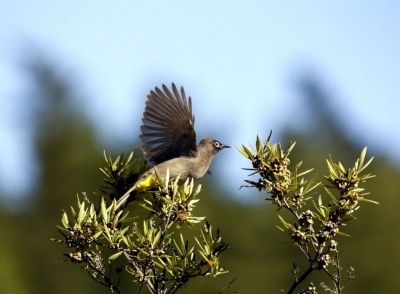(→Distribution: Endemic to south-western South Africa.) |
(→External Links: Video link removed as no longer available. GSearch checked template) |
||
| (13 intermediate revisions by 5 users not shown) | |||
| Line 1: | Line 1: | ||
| − | [[ | + | [[Image:Cape_Bulbul.jpg|thumb|550px|right|Photo © by {{user|Mybs|Mybs}}<br />Kirstenbosch Botanical Gardens, near Cape Town,[[South Africa]], 12 September 2004]] |
;[[:Category:Pycnonotus|Pycnonotus]] capensis | ;[[:Category:Pycnonotus|Pycnonotus]] capensis | ||
| − | |||
==Identification== | ==Identification== | ||
| − | + | '''Length 19-21 cm 7-8"'''<br /> | |
| + | ====Adult==== | ||
| + | [[Image:Cape bulbul2.jpg|thumb|400px|right|Photo © by {{user|xmesox|Bryn De Kocks}}<br />Somerset West, [[South Africa]], 30 April 2011]] | ||
| + | A dark brown bird, with a distinctive white eye-ring, and yellow vent. | ||
| + | ====Juvenile==== | ||
| + | Lacks white eye-ring. | ||
| + | ====Similar Species==== | ||
| + | The white eye-ring distinguishes adults of this species from the similar [[Dark-capped Bulbul]] and [[Black-fronted Bulbul]]. Also Cape Bulbul is much darker below. | ||
| − | |||
==Distribution== | ==Distribution== | ||
| − | Endemic to south-western [[South Africa]]. | + | Endemic to southern and south-western Cape Province ([[South Africa]]). |
| + | ==Taxonomy== | ||
| + | This is a [[Dictionary_M-O#M|monotypic]] species<sup>[[#References|[1]]]</sup>. | ||
| − | |||
==Habitat== | ==Habitat== | ||
| − | + | Coastal scrub, riverine forests, exotic plantations and gardens. | |
| − | + | ==Behaviour== | |
| − | ==Diet== | + | Usually seen in pairs or small noisy groups. Inclined to sit at the top of a bush. |
| − | + | ====Diet==== | |
| − | == | + | They eat fruit, nectar and insects. |
| − | + | ====Breeding==== | |
| + | Nesting season September to November.<br /> | ||
| + | The cup-shaped, thick walled nest is formed inside the foliage of a small tree or shrusb. | ||
| + | ====Vocalizations==== | ||
| + | Call is a sharp, liquid whistle. | ||
| + | |||
| + | ==References== | ||
| + | #{{Ref-Clements6thAug17}}#Fishpool, L. & Tobias, J. (2018). Cape Bulbul (''Pycnonotus capensis''). In: del Hoyo, J., Elliott, A., Sargatal, J., Christie, D.A. & de Juana, E. (eds.). Handbook of the Birds of the World Alive. Lynx Edicions, Barcelona. (retrieved from https://www.hbw.com/node/57941 on 22 June 2018). | ||
| + | #{{Ref-Hockeyetal05}}#birdlife.org.za | ||
| + | #BF member observations | ||
| + | {{ref}} | ||
| + | |||
==External Links== | ==External Links== | ||
{{GSearch|Pycnonotus+capensis}} | {{GSearch|Pycnonotus+capensis}} | ||
| + | {{GS-checked}} | ||
| + | <br /> | ||
| + | <br /> | ||
| − | [[Category:Birds]] | + | [[Category:Birds]][[Category:Pycnonotus]] |
Latest revision as of 20:45, 20 November 2021
- Pycnonotus capensis
Identification
Length 19-21 cm 7-8"
Adult
A dark brown bird, with a distinctive white eye-ring, and yellow vent.
Juvenile
Lacks white eye-ring.
Similar Species
The white eye-ring distinguishes adults of this species from the similar Dark-capped Bulbul and Black-fronted Bulbul. Also Cape Bulbul is much darker below.
Distribution
Endemic to southern and south-western Cape Province (South Africa).
Taxonomy
This is a monotypic species[1].
Habitat
Coastal scrub, riverine forests, exotic plantations and gardens.
Behaviour
Usually seen in pairs or small noisy groups. Inclined to sit at the top of a bush.
Diet
They eat fruit, nectar and insects.
Breeding
Nesting season September to November.
The cup-shaped, thick walled nest is formed inside the foliage of a small tree or shrusb.
Vocalizations
Call is a sharp, liquid whistle.
References
- Clements, J. F., T. S. Schulenberg, M. J. Iliff, D. Roberson, T. A. Fredericks, B. L. Sullivan, and C. L. Wood. 2017. The eBird/Clements checklist of birds of the world: v2017, with updates to August 2017. Downloaded from http://www.birds.cornell.edu/clementschecklist/download/
- Fishpool, L. & Tobias, J. (2018). Cape Bulbul (Pycnonotus capensis). In: del Hoyo, J., Elliott, A., Sargatal, J., Christie, D.A. & de Juana, E. (eds.). Handbook of the Birds of the World Alive. Lynx Edicions, Barcelona. (retrieved from https://www.hbw.com/node/57941 on 22 June 2018).
- Hockey, PAR, WRJ Dean, and PG Ryan, eds. 2005. Roberts' Birds of Southern Africa. 7th ed. Cape Town: John Voelcker Bird Book Fund. ISBN 978-0620340533
- birdlife.org.za
- BF member observations
Recommended Citation
- BirdForum Opus contributors. (2024) Cape Bulbul. In: BirdForum, the forum for wild birds and birding. Retrieved 21 May 2024 from https://www.birdforum.net/opus/Cape_Bulbul
External Links
GSearch checked for 2020 platform.





